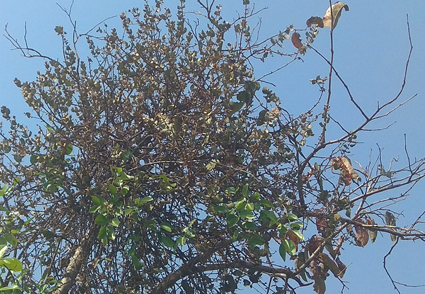Abstract
Scurrula stocksii (Hook.f.) Danser (Loranthaceae) is a rare parasitic plant species and restricted to the Maharashtra state of India. S. stocksii was described based on specimens collected by J.E. Stocks from Konkan region of Maharashtra. Cooke (1908) reported the species from Savantwadi area of Sindhudurg district of Konkan region of Maharashtra based on collection of Kanitkar. Mishra & Singh (2001) stated that in spite of intensive searching the species could not be traced in Sindhudurg district and might have been vanished from this district. While surveying Rajapur area of Ratnagiri District (Maharashtra), S. stocksii collected, therefore this collection represents the rediscovery after 127 years. Lectotype for Loranthus stocksii Hook.f. is designated here by ICN (Shenzhen code, 2018).
References
<p align="justify"><span style="color: #000000;"><span style="font-family: Times New Roman, serif;"><span style="font-size: small;">Bhagat, R.B., Chambhare, M., Mate, S., Dudhale, A. & Zaware, B.N. (2016) Prospective wild edible fruit plants from part of northern Western Ghats (NWG), Mulshi (MS), India. <em>Journal of Medicinal Plants Studies</em> 4 (1): 15‒19.</span></span></span></p>
<p align="justify"><span style="color: #000000;"><span style="font-family: Times New Roman, serif;"><span style="font-size: small;">Danser, B.H. (1929) On the taxonomy and nomenclature of the Loranthaceae of Asia and Australia. <em>Bulletin du Jardin Botanique</em> 3 (10): 348‒354.</span></span></span></p>
<p align="justify"><span style="color: #000000;"><span style="font-family: Times New Roman, serif;"><span style="font-size: small;">Gaikwad, S., Gore, R., Krushnadeoray, G. & Gaikwad, S. (2014) Endemic flowering plants of nothern Western Ghats (Sahyadri Ranges) of India: A checklist. <em>Check List, Journal of species lists and distribution</em> 10 (3): 461–472. https://doi.org/10.15560/10.3.461 </span></span></span></p>
<p align="justify"><span style="color: #000000;"><span style="font-family: Times New Roman, serif;"><span style="font-size: small;">Hooker, J.D. (1886) <em>The Flora of British India, Vol. 5. </em>Reeve & Co., London, 213 pp.</span></span></span></p>
<p align="justify"><span style="color: #000000;"><span style="font-family: Times New Roman, serif;"><span style="font-size: small;">Linnaeus, C. (1753) <em>Species Plantarum </em>1. 110 pp.</span></span></span></p>
<p align="justify"><span style="color: #000000;"><span style="font-family: Times New Roman, serif;"><span style="font-size: small;">Mishra, D.K. & Singh, N.P. (2001) <em>Endemic and threatened flowering plants of Maharashtra</em>. BSI, Calcutta, pp. 200‒201.</span></span></span></p>
<p align="justify"><span style="color: #000000;"><span style="font-family: Times New Roman, serif;"><span style="font-size: small;">POWO (2022) Plants of the World Online. Facilitated by the Royal Botanic Gardens, Kew. Available from: https://powo.science.kew.org/results?q=scurrula (accessed 30 November 2022).</span></span></span></p>
<p align="justify"><span style="color: #000000;"><span style="font-family: Times New Roman, serif;"><span style="font-size: small;">Roth, A.W. (1821) <em>Novae Plantarum Species praesertim Indiae Orientalis: Ex collection doct. Benj. Heunii: cum descriptionibus et observationibus. </em>Halberstadii: Sumptibus H. Vogleri. pp. 383. https://doi.org/10.5962/bhl.title.10723 </span></span></span></p>
<p align="justify"><span style="color: #000000;"><span style="font-family: Times New Roman, serif;"><span style="font-size: small;">Singh, N.P., Lakshminarasimhan, P., Karthikeyan, S. & Prasanna, P.V. (2001) <em>Flora of Maharashtra State: Dicotyledons</em>, <em>Vol. 2.</em> BSI, Kolkata, 844 pp. </span></span></span></p>
<p align="justify"><span style="color: #000000;"><span style="font-family: Times New Roman, serif;"><span style="font-size: small;">Singh, L.J. (2015) <em>Scurrula paramjitii</em> L.J.Singh: A New Species (Loranthaceae) from the Andaman and Nicobar Islands, India. <em>Taiwania</em> 60: 123‒128. https://doi.org/10.6165/tai.2015.60.123</span></span></span></p>
<p align="justify"><span style="color: #000000;"><span style="font-family: Times New Roman, serif;"><span style="font-size: small;">Turland, N.J., Wiersema, J.H., Barrie, F.R., Greuter, W., Hawksworth, D.L., Herendeen, P.S., Knapp, S., Kusber, W.H., Li, D.Z., Marhold, K., May, T.W., Mcneill, J., Monro, A.M., Prado, J., Price, M.J. & Smith, G.F. (eds.) (2018) <em>International Code of Nomenclature for algae, fungi, and plants (Shenzhen Code) adopted by the Nineteenth International Botanical Congress; Shenzhen, China, July 2017. </em>Regnum Vegetabile 159. Koeltz Botanical Books, Glashütten. https://doi.org/10.12705/Code.2018</span></span></span></p>


